Nothing beats the freedom of driving down any road you see and stopping wherever you want.

Ramshackle fishing villages, rich folklore and heritage, rural tranquility and a charming character.
Not too far south of Puerto Montt and Puerto Varas is the largest of the 41 islands that dot the expansive Chiloé archipelago. Many day tours can offer a taste of what some of the Chiloé Island is about, but for around $40 a day, a very affordable way to do it is with your own rented wheels.
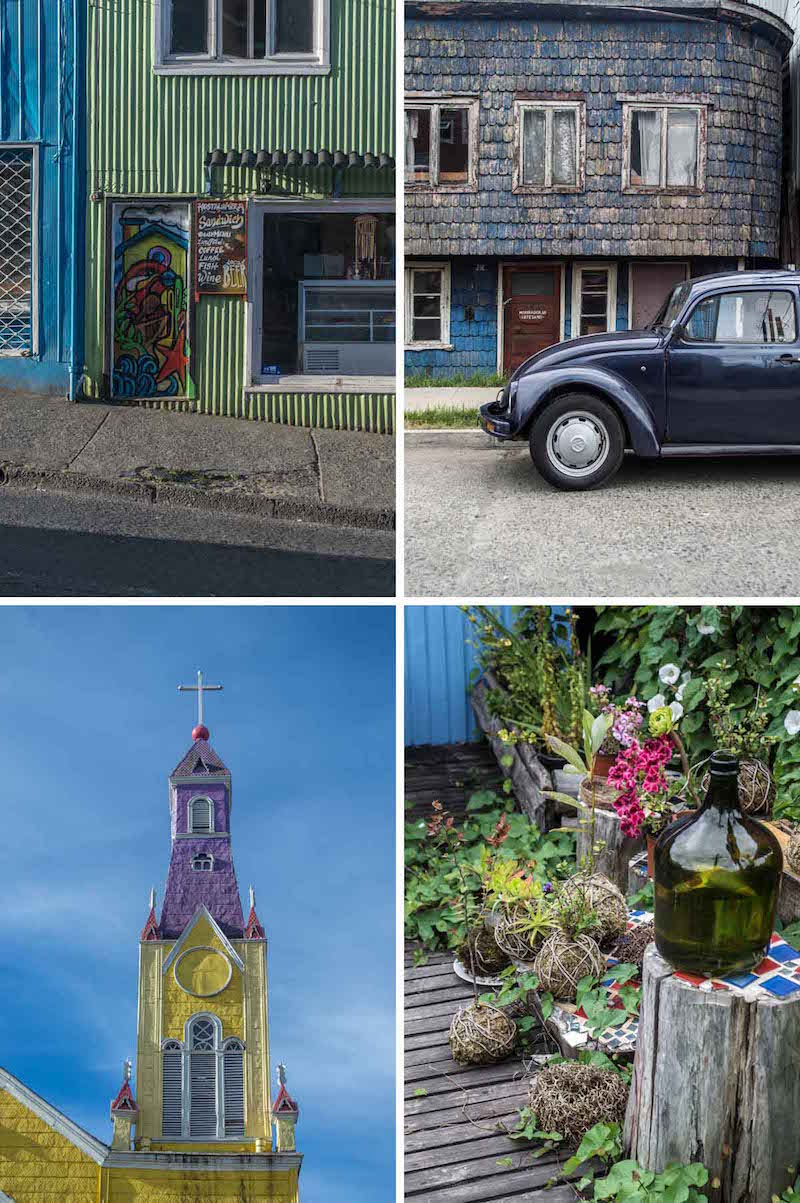
A great place to base yourself is in the small city of Castro. Known for its colourful palafitos, or wooden fishermen’s houses, Castro is an energetic city that’s a bit rough around the edges, but has a great deal of rustic charm.

Plaza de Armas is very popular with locals enjoying the open space, is flanked by shady trees and dominated by the candy-coloured and UNESCO listed Iglesia San Francisco. Of the numerous wooden churches that can be found all over the island, the Neo-Gothic church is the only one that’s clad in metal

Head down the hill towards the water and you pass a bunch of cafes and eateries, bars and shops selling items made with the island’s high quality and naturally-dyed wool.
Hang a right at the ferry wharf and you end up at Castro Market and several overwater restaurants that specialise in local dishes that are heavy in seafood. We never made it to any of the restaurants, to my disappointment, but we got a good taste of Mercado Municipal Lillo – or Castro Market.
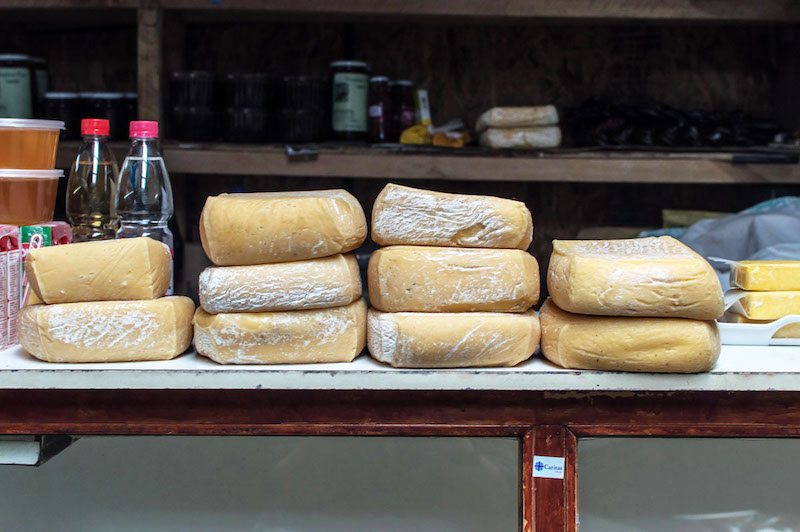
Here at the market you’ll fine many stalls selling fresh fruits and vegetables, including the very colourful small potato varieties grown locally, called papas Chilotes. Dried herbs are strung up and hung alongside smoked and dried mussels, red sea squirts and clams, braids of garlic and bags of ground spices.
Something you can’t miss are the dried bundles of cochayuyo, dried bull kelp. Lift one to your nose and you may gag a little, but I’m expecting the flavour isn’t so pungent and intense once it’s rehydrated and cooked in a soup or stew.
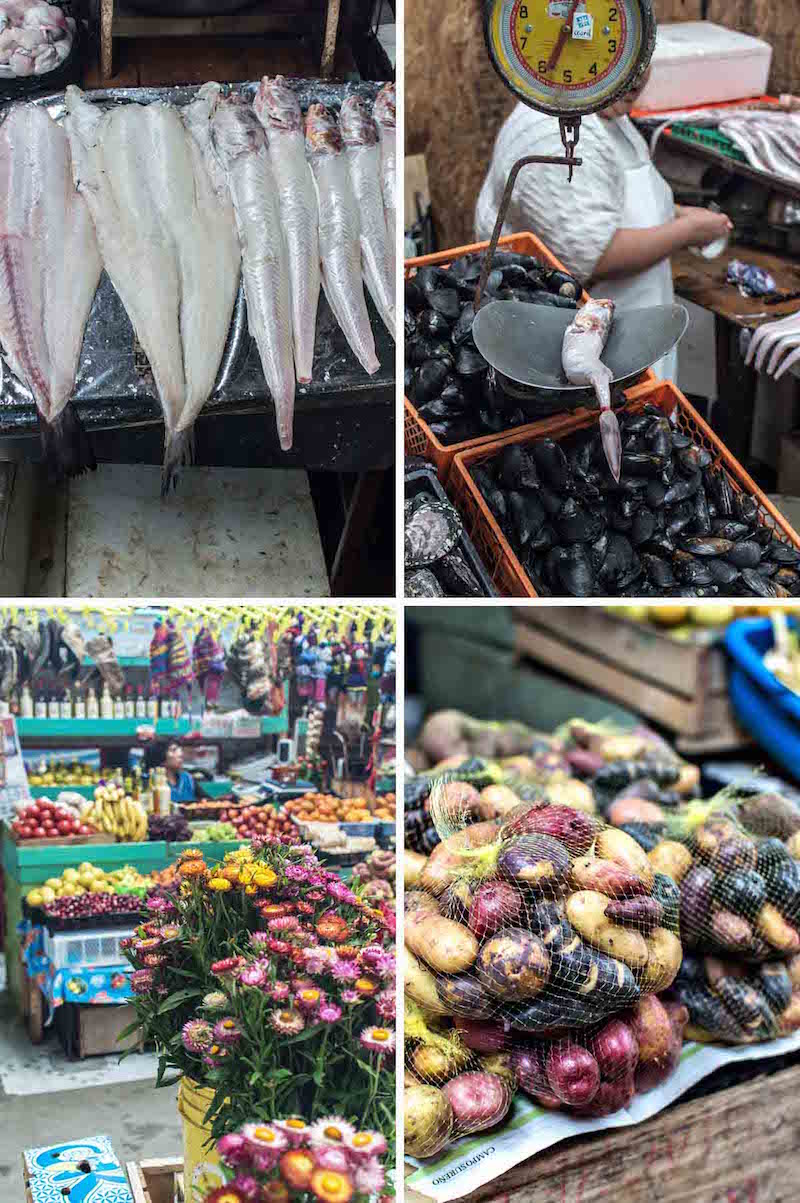
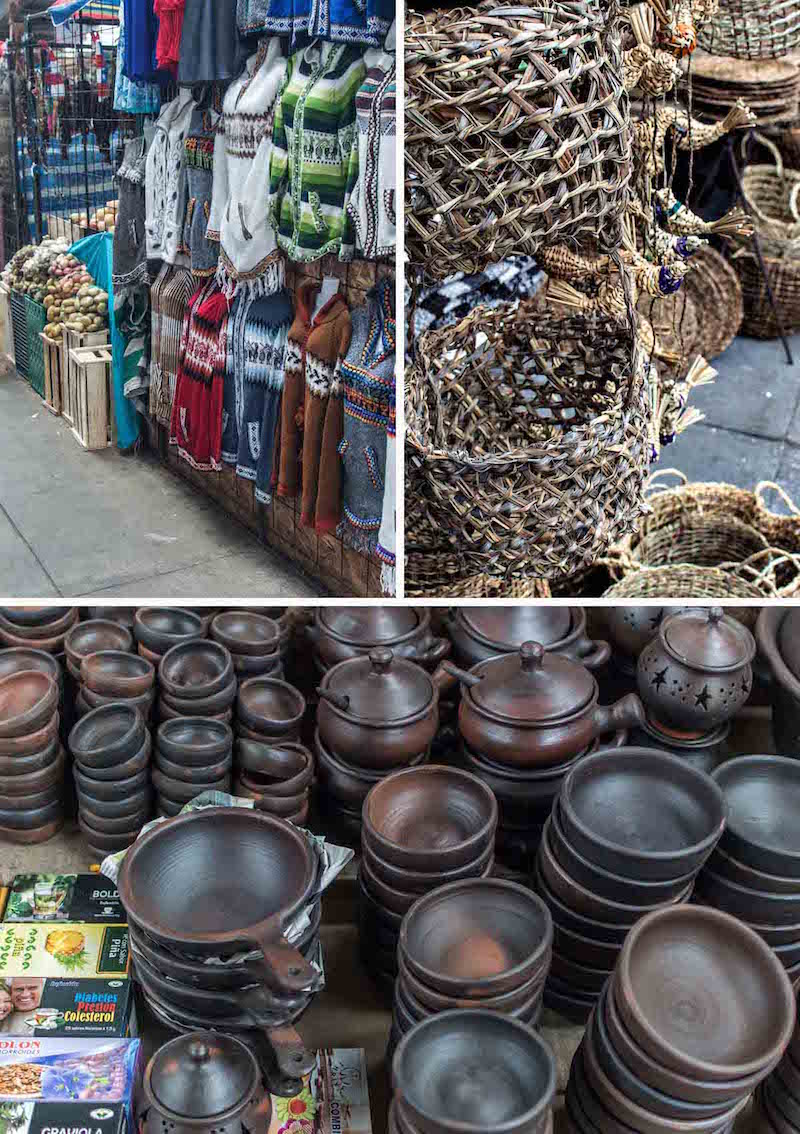
‘Bricks’ of luche (dried sea lettuce) sit in piles by organic eggs and buckets of fresh flowers and local artisan cheeses.
There’s plenty of fresh seafood to purchase, or course, and one mustn’t miss the salmon ceviche they sell from buckets at many of the stands.
Handicrafts are very present at the market – namely woollen jumpers, socks, hats and clothing. A lot of it isn’t from the area, so I’d check before buying if you’re only interested in the locally crafted wares. Plenty of basketware, some souvenirs and black clay earthenware, as well.
Mercado Municipal Lillo, Eusebio Lillo 130-138


Aside from the overwater seafood restaurants next to the market, there’s a string of local eateries on the street adjacent. Restaurante Donde Eladio is a friendly and very popular place with your typical Chilean menu that’s heavy in seafood.
As the original Ghost Busters movie played on the television nearby, how nostalgic, we tucked into something that many restaurants served on the island – conger eel. One of them came frito (fried) and the other – congrio mantequilla (7,550) – steamed with butter in foil). Absolutely delicious.
Restaurante Donde Eladio, Eusebio Lillo 130-138
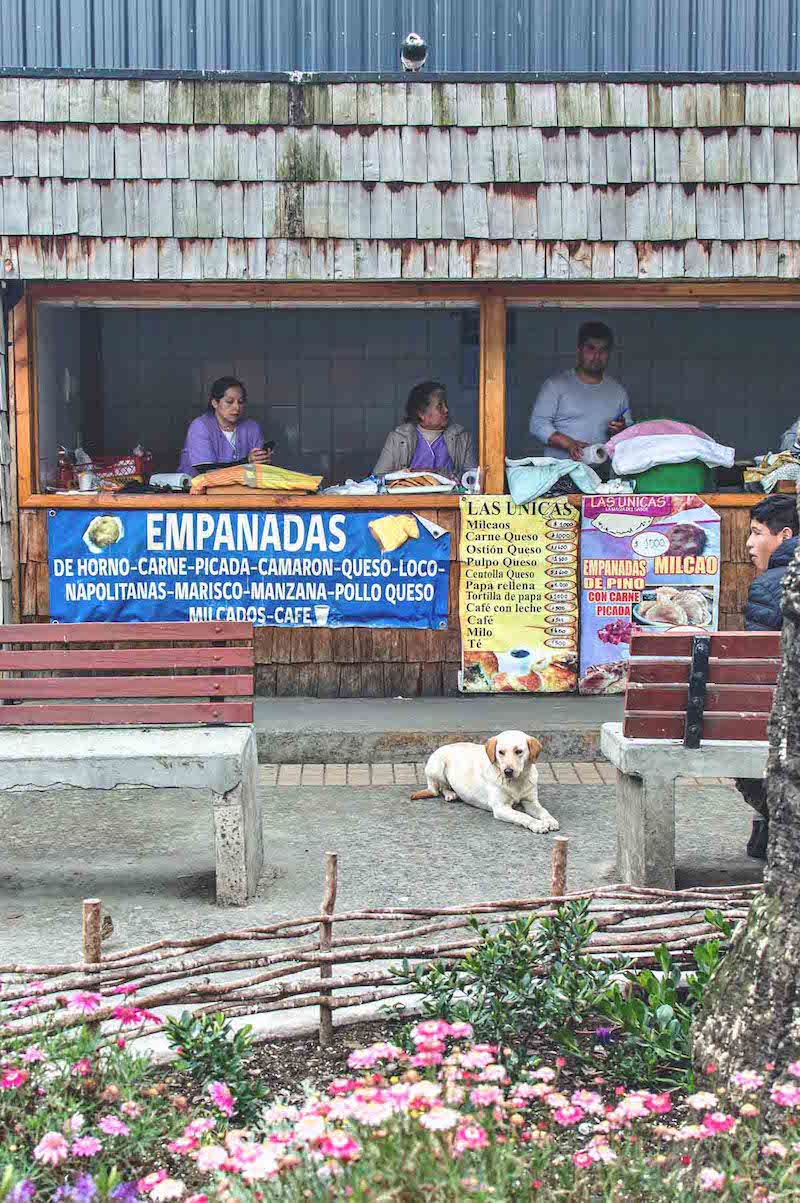
Up on San Martín, one of the city’s main drags, you can find a bunch of people selling homemade empanadas in one convenient location. They’re all cooked and ready to eat or take away – and very well priced, too.
Empanada Stands, Corner Emilio Sotomayor & San Martín
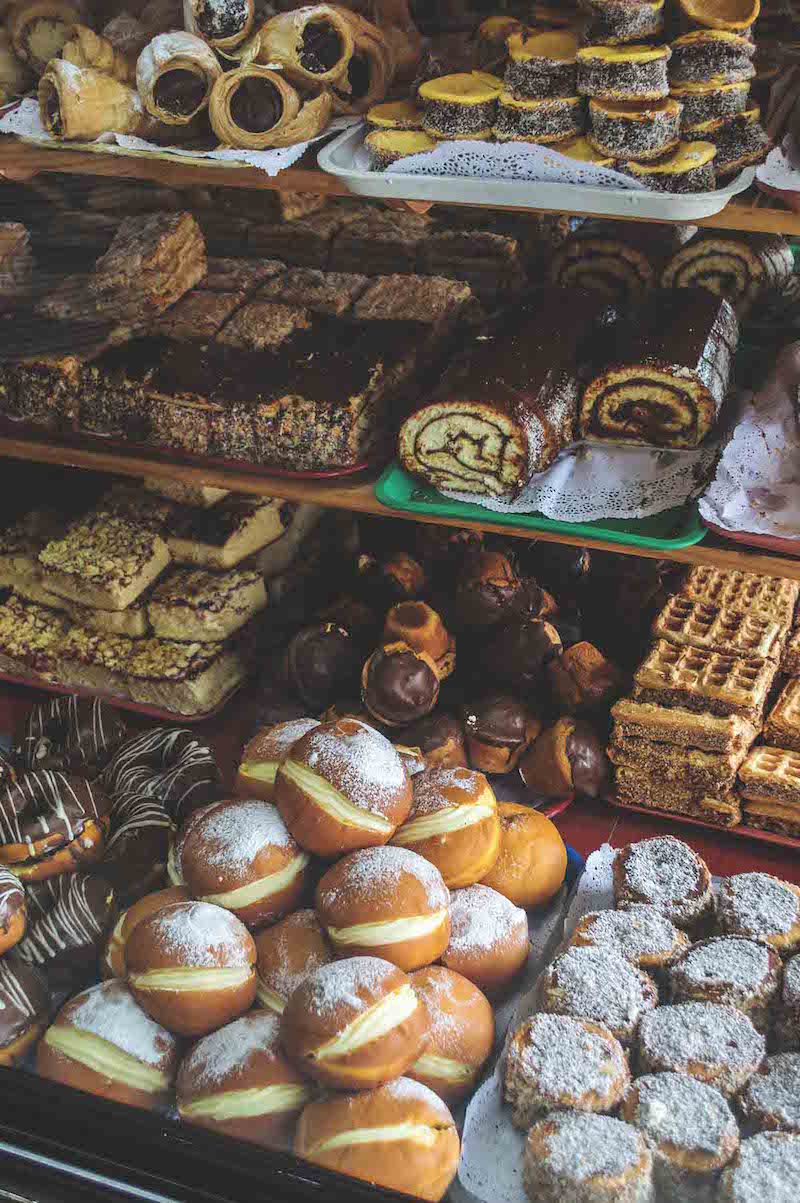
One block away is Top Ten, a tiny bakey that’s jam-packed with just about any Chilean baked goodies you can think of. Tres leches cake, brazo de reina (like a Swiss roll), alfajores, milhojas and those glorious custard-filled Berliners.
It’s a true “kid in the candy store” situation when you enter this one!
Top Ten, San Martín 648

One thing that really grabbed my attention on the streets of Castro was these stunning things. As we travelled through this part of Chile I noticed a lot of a certain plant growing on the roadside. When we got to Chiloé it was noticeably growing wild everywhere.
What is it?
This is nalca, a giant plant unrelated to, but similar to rhubarb. What you see above is the stem – something that’s around 1 metre long and often up to two inches thick. It’s cut into chunks, semi-peeled and sliced down the centre and sold with a small packet of salt.
You basically sprinkle a little salt on the juicy and incredibly sour stem, crunch into it and chew until there’s only stringy fibre in your mouth. I can only assume I’m meant to spit that out as it’s too tough to eat. Keep scrolling and you’ll see my pics of the actual plant on a trek we did.
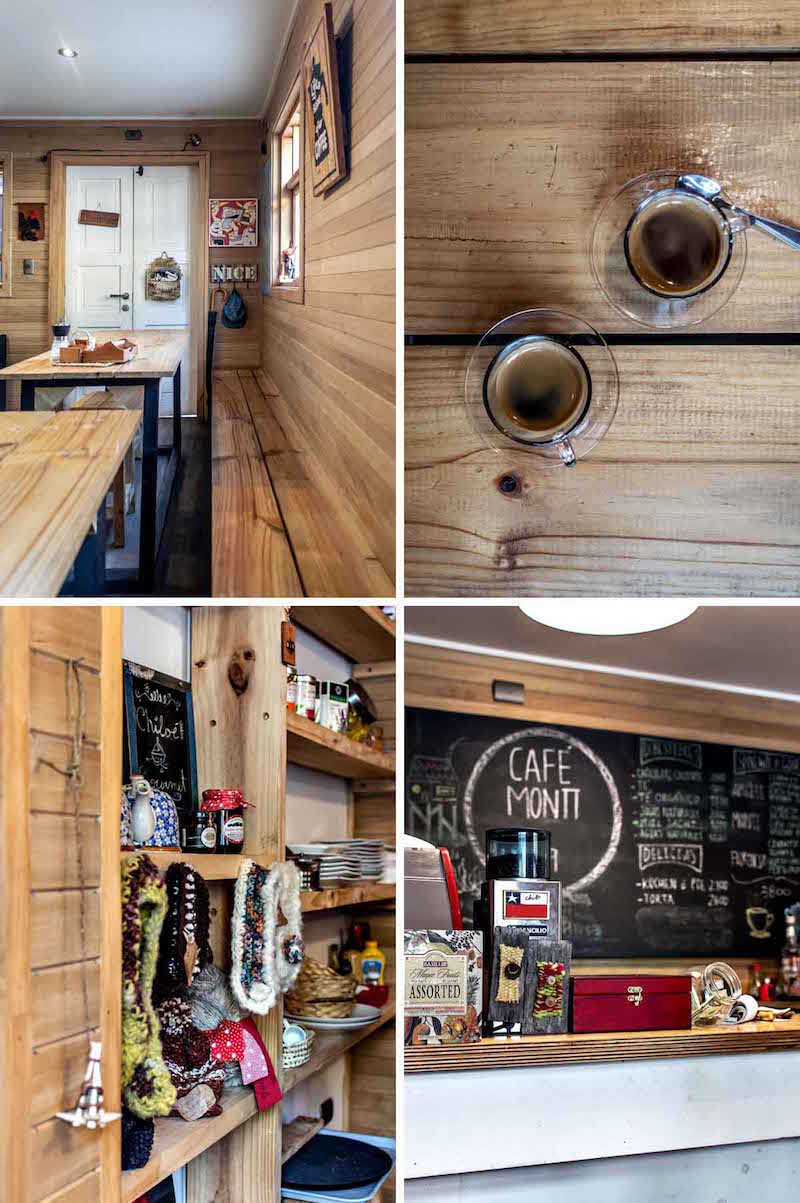
Cafes with decent coffee are far and few between, in Castro, but there are a couple worth checking out. What’s meant to be the best – Cafe Patagonia – was closed when we dropped by, but there is one other little joint that was far from shabby.
Head down to the palafitos on Pedro Montt and you’ll find the aptly-named Cafe Montt, a friendly little place with a slight Scandi touch. They also do tea, cakes and ciabatta sandwiches and even sell a few handicrafts.
Cafe Montt, Pendro Montt 599

For the alcoholic stuff, there are plenty of places around the main plaza and its surrounding streets. You just need to look around.
Q’uiú Restobar is a sprawling space that has pizza, pasta, Mexican and local food on its menu, and a very well stocked bar for those of us that are there to cool down with a drink. If the space was air-conditioned you could cool down even more, but there is the option of sitting outside in the smoking area.
There’s always something going on at Q’uiú enjoy live music, entertainment and even karaoke for those that like to belt out an off-key tune.
Q’uiú Restobar, Balmaceda 289
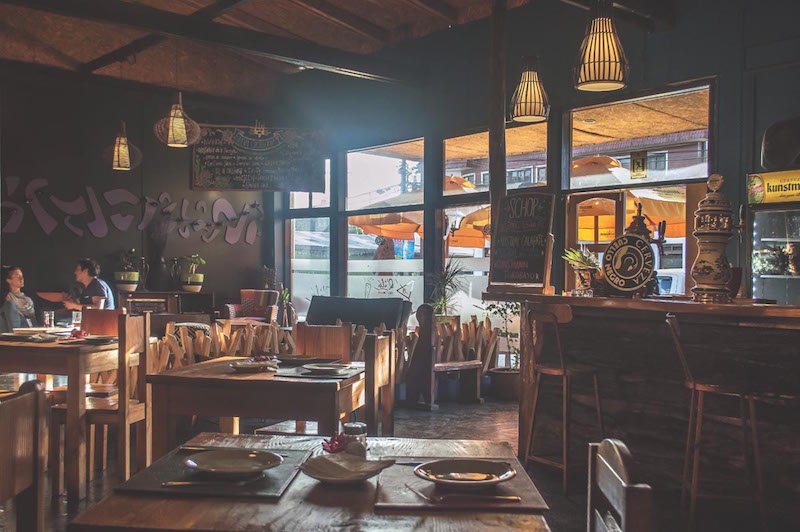
On one of the corners opposite the plaza is this rustic little restaurant and bar that’s open for late breakfast, lunch and dinner. Salzburg beer is on tap, the menu features a lot of seafood, plus there are burgers, steaks and local food done with flair.
Great place just to chill with a beer in the afternoon.
Descarriada, Blanco Encalada 306

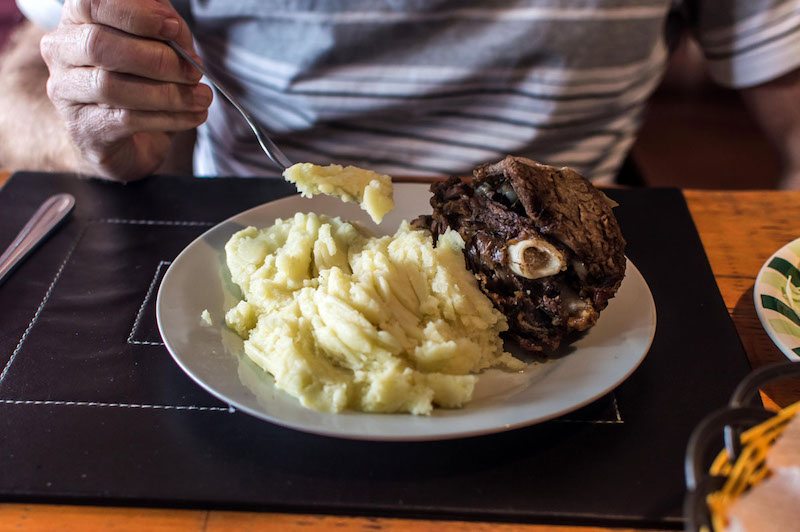
Finding cheap eats in Castro isn’t too much of a challenge, and when you’ve found somewhere that does a set lunch menu for 3,000 pesos (AUD$6), you’ve kind of struck gold.
Head to the Ari Hostal and you can fill up on local food, even if you may not know what you’re going to get. Let’s blame our lack knowing how to read Spanish on that one!
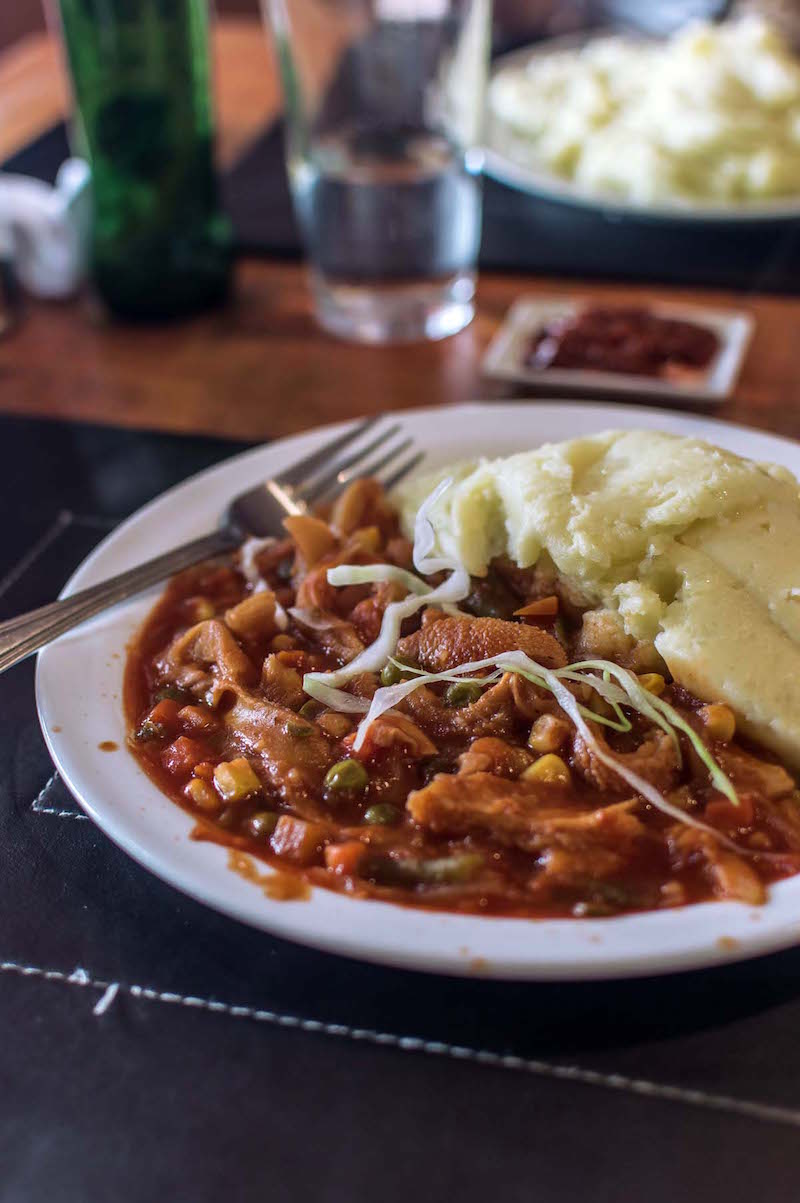
Sopa as a starter, which was chicken soup on this particular day, with a few bits of offal lurking in the depths. Dean went for the asado do cordero, something we could understand, which is roast lamb. The great hunk of lamb shank that came out was impressive in size and served with a rather tasty mash. Sadly the meat on the shank gave the teeth a serious workout. Muy rudo!
I chose blindly and settled on a bunch of words I knew nothing about – guatita a la jardinera. Ok, the jardinera I knew, which is gardener, but the rest baffled me. Couldn’t be too bad, could it?
Well, what I ended up getting was a very rich tripe stew with mash. I can eat tripe on the occasion, but this one was a little too powerful in the flavour department. Several wobbly bits of cow stomach, some peas and mash and I was done. Sorry, guys, it defeated me.
A shredded cabbage salad also came with the lunch menu.
Ari, Balmacida 245
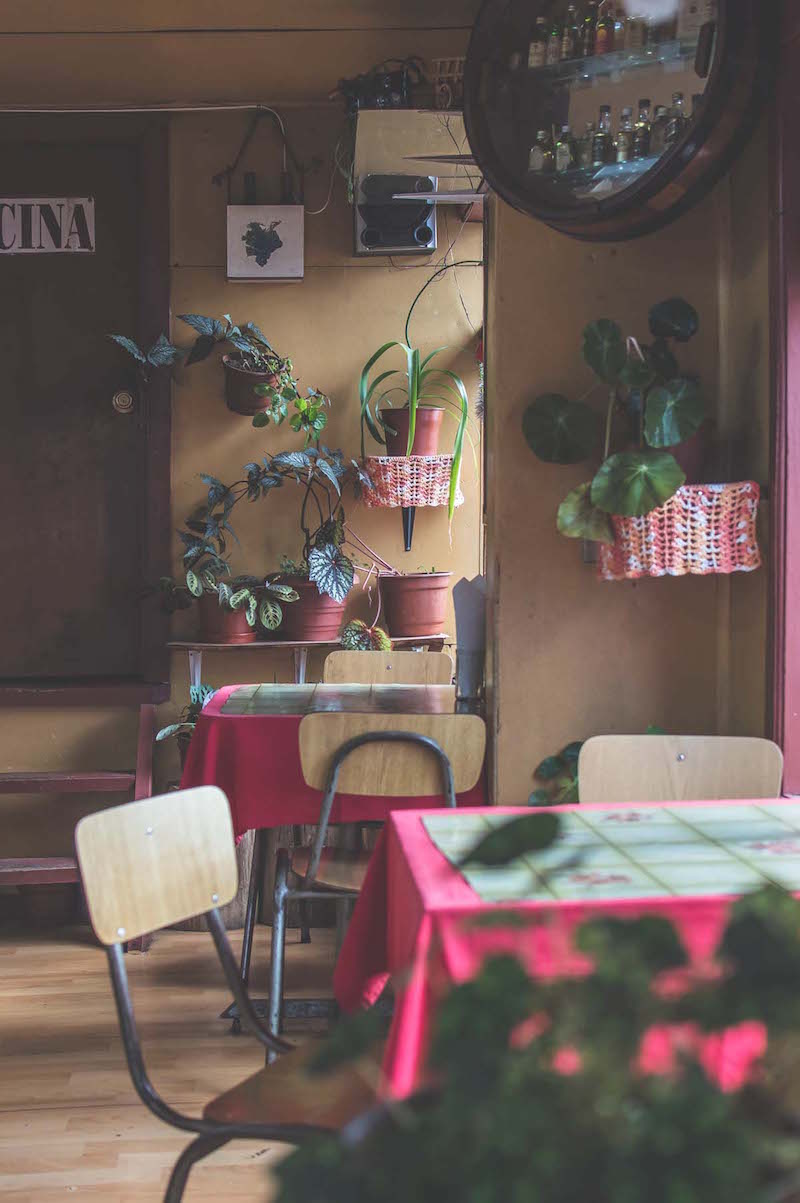
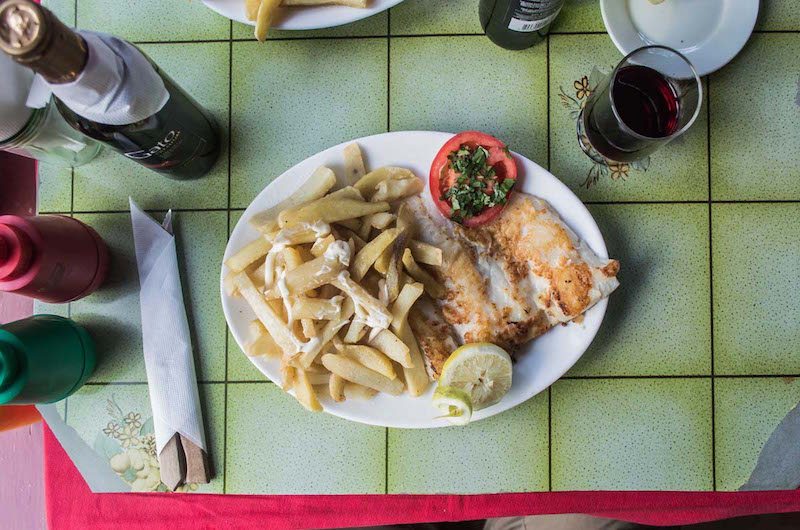
Another cheap and cheerful, and many like it, can be found up on San Martín near the bus terminal. Up above the shops is Chilo’s Cafe, where you can step back in time and enjoy decor rich in plywood and vinyl; all whilst chowing on sandwiches, carne and seafood.
Merluza con papas 4800 (hake with chips) was the go, for us, with a little vino to get right into the mood. Great fish, actually, perfectly grilled and as juicy as ever.
Chilo’s Cafe, San Martín 679
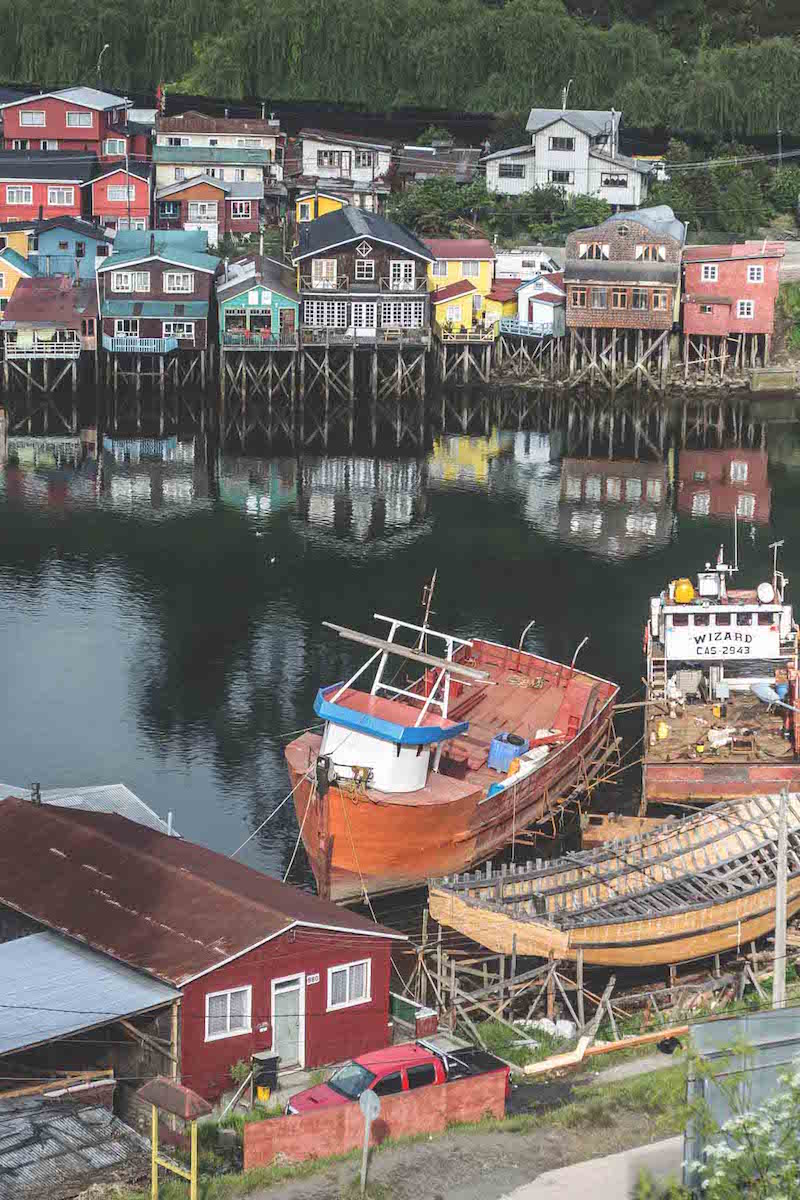
That’s it for Castro, so why not see what we got up to as we drove around the island. Not before stopping off at the most photographed palafitos in Castro, of course. At low tide the stilt houses overlook mud that’s a bit on-the-nose, but at high tide it’s a whole different look. Many of these palafitos are residential, but there are a few restaurants and rather nice hotels, as well. A bit over our budget.

As I mentioned earlier about the churches on Chiloé, there were once 150 wooden churches that once stood on the islands in the archipelago. Built by local craftsmen for Jesuit missionaries, the churches were constructed entirely of wood using ship-building techniques. Only 60 conforming to the Chiloe school typology remain; 16 of which are UNESCO listed.
There is a designated ‘church drive’ you can do on the island, but we just stopped at a handful, such as Iglesia de Nercón in the above photo, located a few kilometres south of Castro.
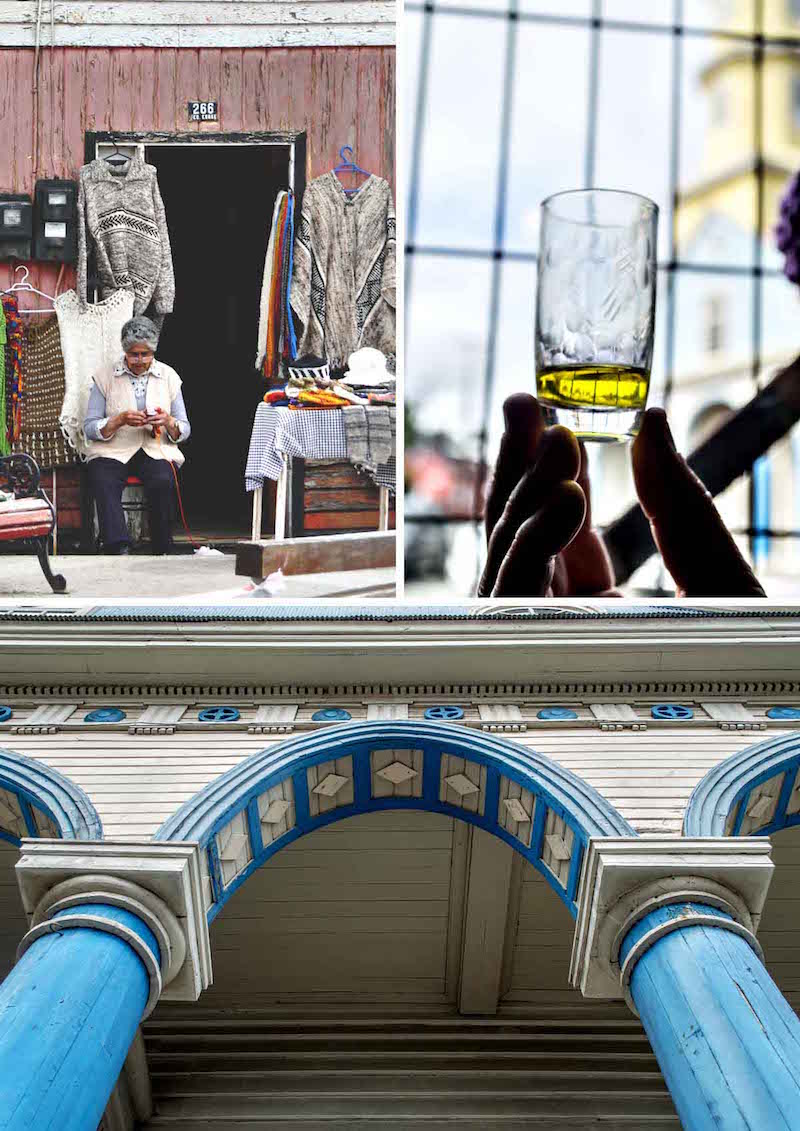
Taking a wrong turn brought us to the small village of Chonchi, another place with a wooden church and our chance to sample a drink that’s unique to the village – licor de oro.
The gorgeous lady knitting in the pic above invited us into her store, showing us the woollen clothing, scarves, beanies and slippers she made herself, then poured us a glass of licor de oro. I’m now kicking myself for not buying a bottle from her as it’s absolutely divine.
Licor de oro, or gold liqueur, is made by mixing whey with clear brandy and letting it sit for a week. Saffron and lemon zest is then added, before being filtered. It’s syrupy, sweet, aromatic and very alcoholic. Absolutely delicious stuff!
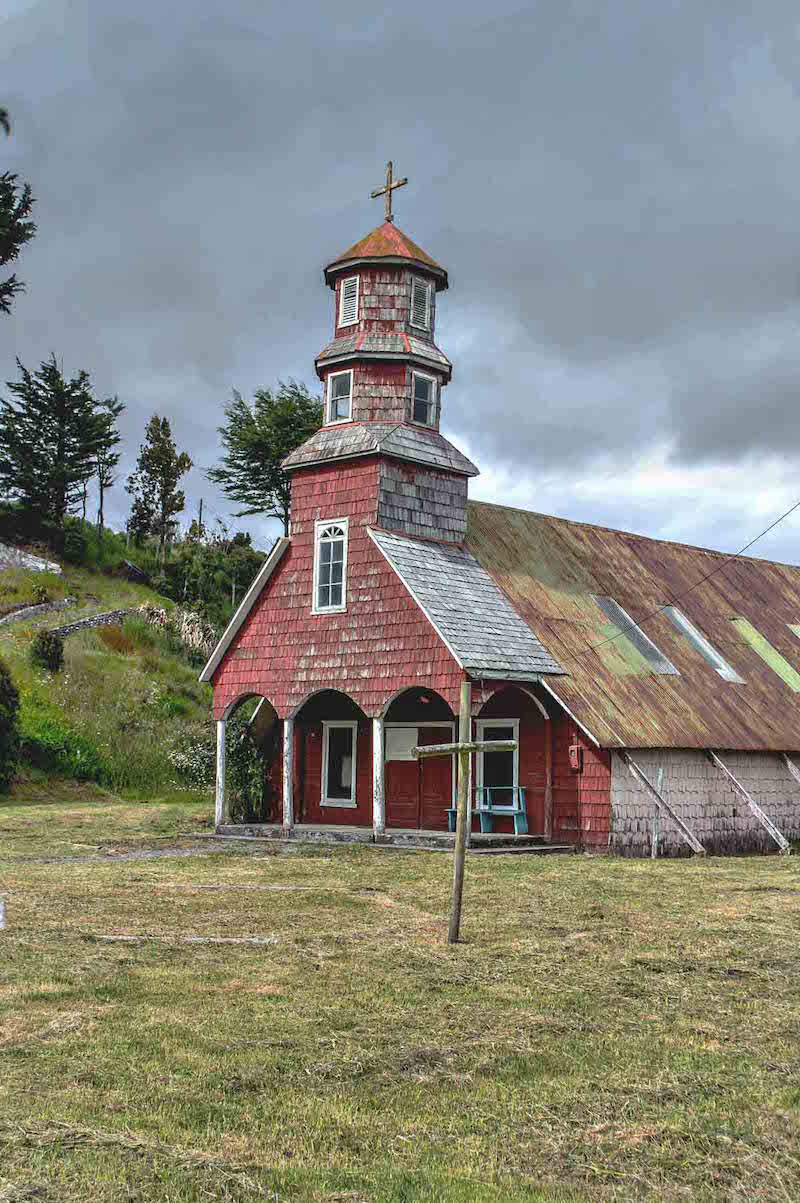
One thing I really wanted to see on the island was Muelle de las Almas, or Dock of Souls, but to get there we needed to do a little driving and some trekking.
Driving to the west coast of the island, where this particular sculpture is located, takes you through rolling hills and though the tiny village of Huillinco. The village itself isn’t much to look at, but its weathered wooden church (above) is definitely worth photographing.
The road then straddles the southern shore of Lago Huillinco (beware the countless potholes!) and then the very rugged west coast and some pretty rough driving that’s more suitable for a 4×4 rather than our tiny city-style car.
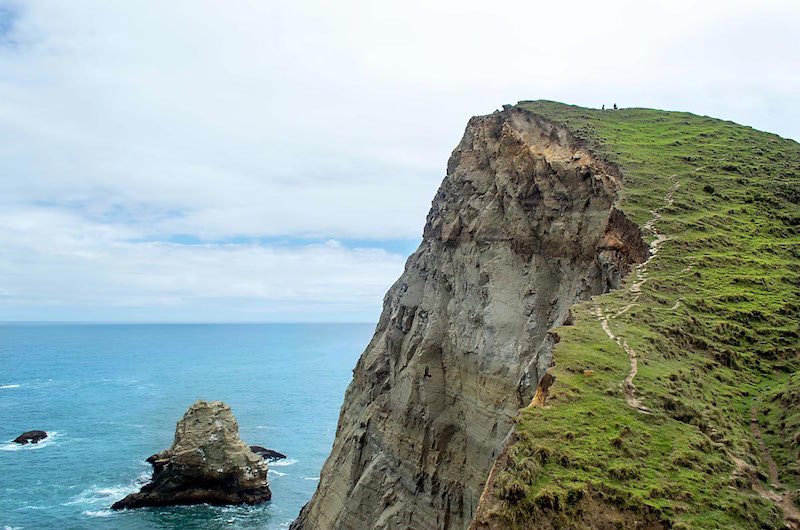
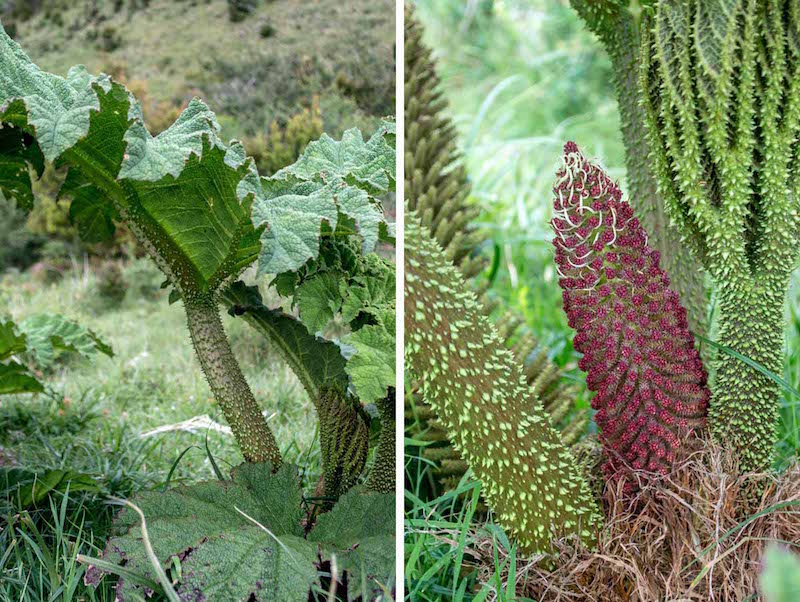
Eventually the bumpy road/track ends at a private property where you park your car for 2000 pesos, then follow a walking trail towards the coast. Another entry onto someone elses private property (1500 pesos) and you continue walking through grassland, over hills and through forest and past huge clumps of nalca (see above pic), eventually arriving at Muelle de las Almas.
This art installation taps into legends of the native Mapuche, where the souls of the dead arrive at a dock from places inland, awaiting the boatmen to carry them to the next world. Many souls are left behind where they linger around the cliffs, with their mournful voices echoing up from the waves and up the cliffs.
Legend has it if you talk back to these voices, within a year your own soul will return back to this spot and never leave.
Those spooky voices are actually real, but rather than souls, they’re the voices of sea lions on a small island not too far from the sculpture.
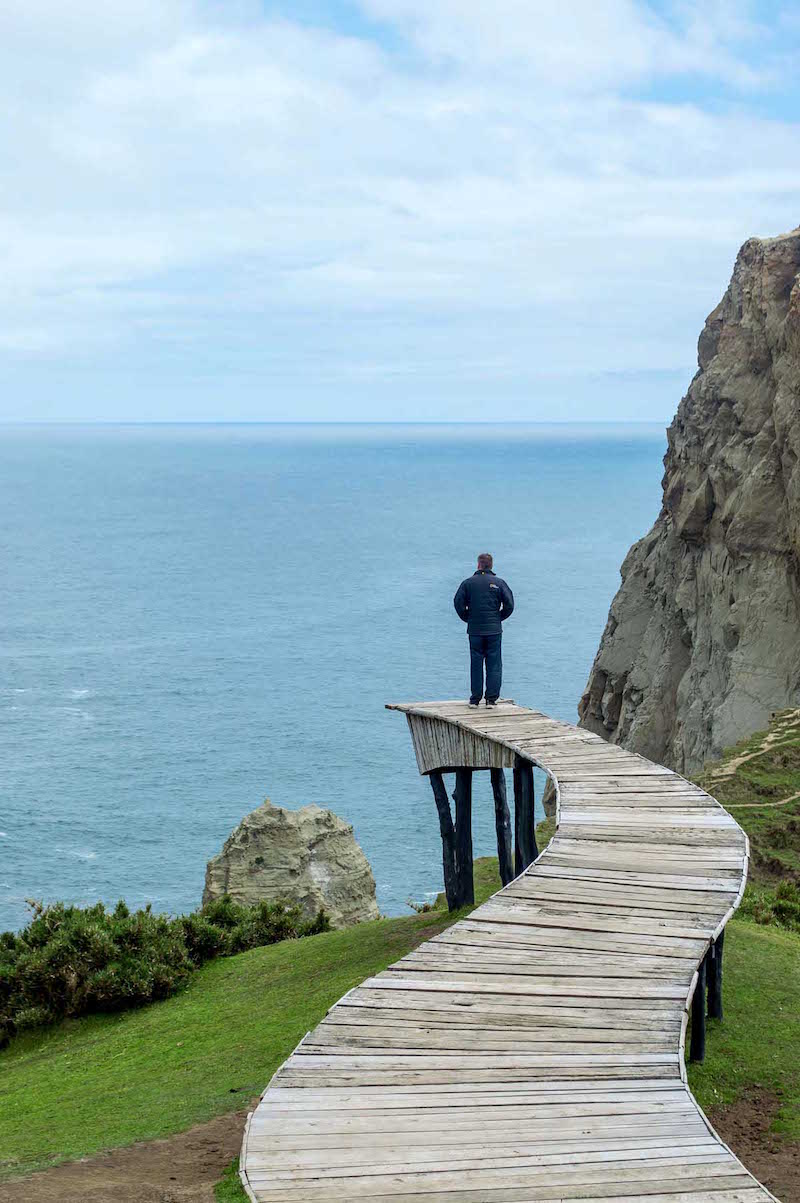

Eating options in that part of the island can be a little sparse, to say the least. We noticed one shack selling empanadas along the gravel road, but aside from that, nada.
Close to the entrance of Chiloé National Park you can find a few places to stay, as well as eat, so one can’t be fussy with choices. Las Terraza de Cucao puts on a hearty set lunch menu, and its main dish of porotos con rienda (beans with ‘reins’) turned out to be one of my favourite meals in all of our Chile travels. Much like the one I had in Puerto Varas, this one contained an enormous lump of the most delicious smoked pork hock. The ‘reins’ refer to the strands of spaghetti in the soup.
Dessert was durazno al jugo, a ‘dryer’ version of mote con huesillo, a refreshing drink made from wheat and peaches, found all over Chile and parts of Bolivia. I love it.
Las Terrazas de Cucao, Chonchi
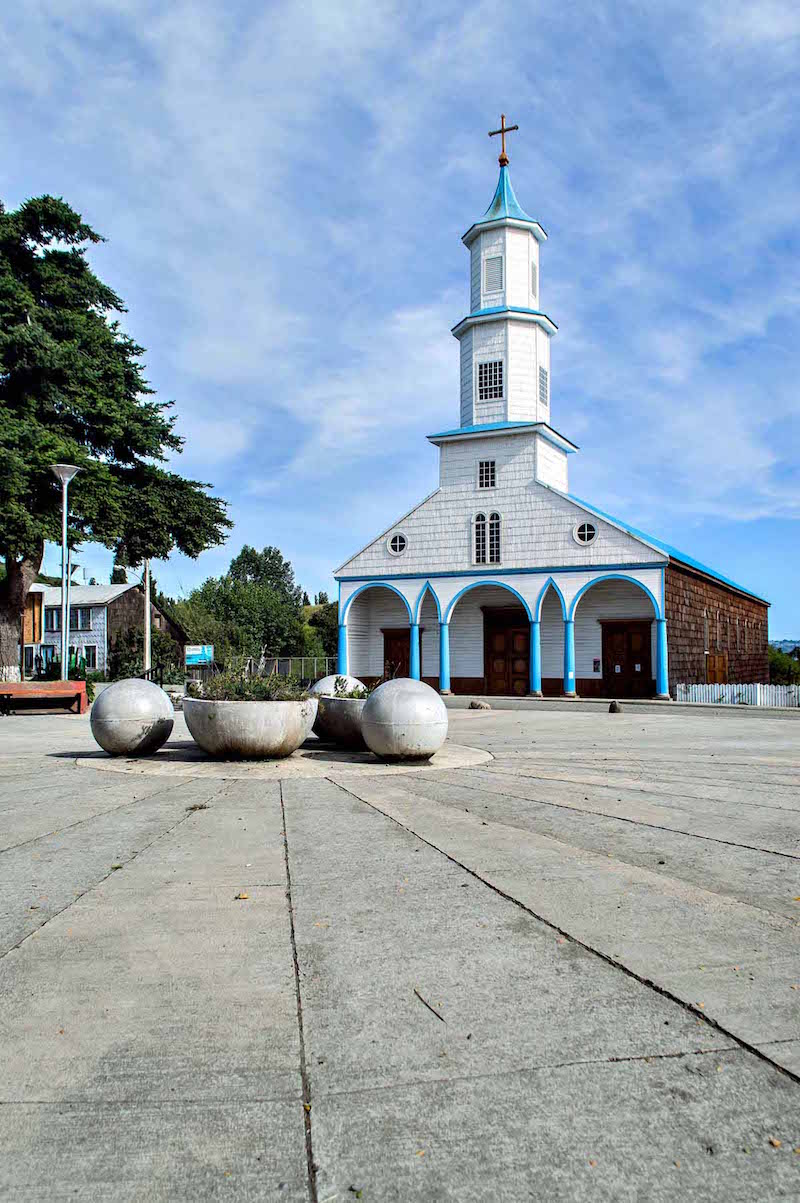
On day two we took the ferry to Isla Quinchao, a rural island dotted with tiny villages, wooden churches and plenty of picturesque dirt roads to drive down and explore.
You can stop in at the sleepy village of Rilan to see its white and blue iglesia on the town square, or the larger seaside town of Achao with its colourful buildings clad in shingles. While you’re there, drop into the tiny marketplace on the waterfront to pick up some locally smoked fish. The views across to the mainland and snowcapped mountains of Northern Patagonia are pretty spectacular, as well.

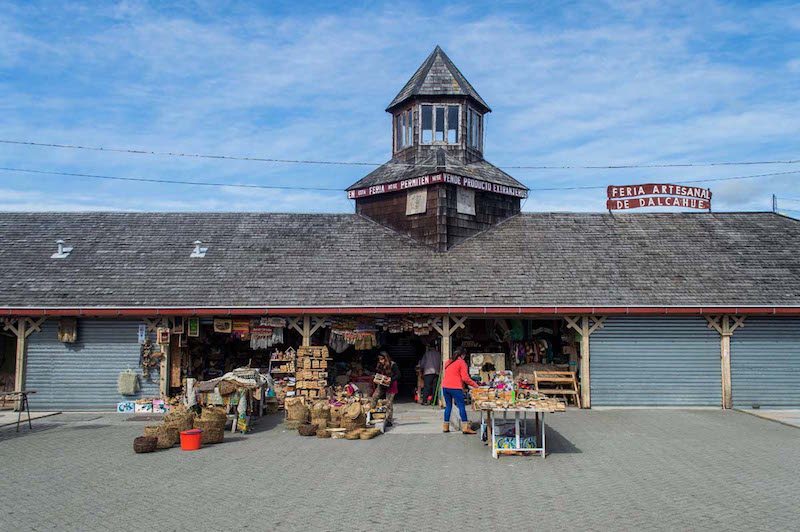
When crossing from Chiloé to Isla Quinchao it’s also worth spending a little time in the port town of Dalcahue. The main commercial part of town isn’t overly exciting, but down around the waterfront there’s a strip of restaurants and shops selling local crafts. A bit more to look at, really.
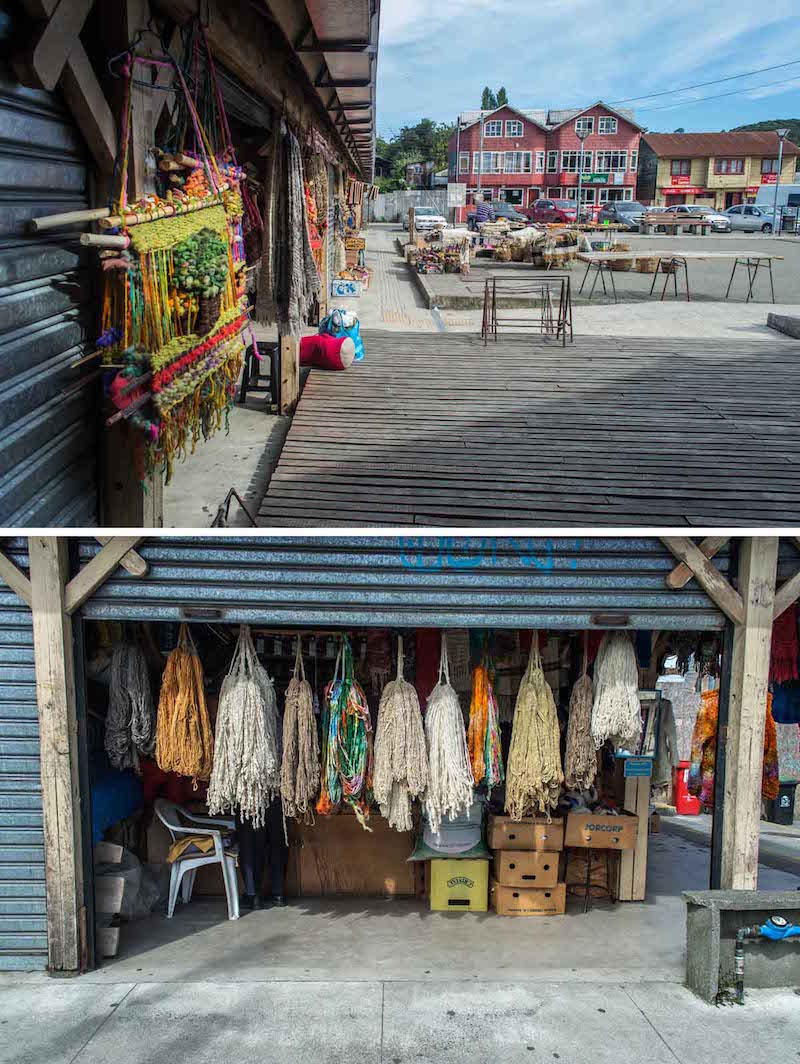
If you’re into your handicrafts and locally made woollen products, Fería Artesanal Dalcahue is where it’s at. The long barn is packed with all things crafty and you could really so some financial damage if you’re partial to this kind of stuff.
Fería Artesanal Dalcahue, Pedro Montt 105-138
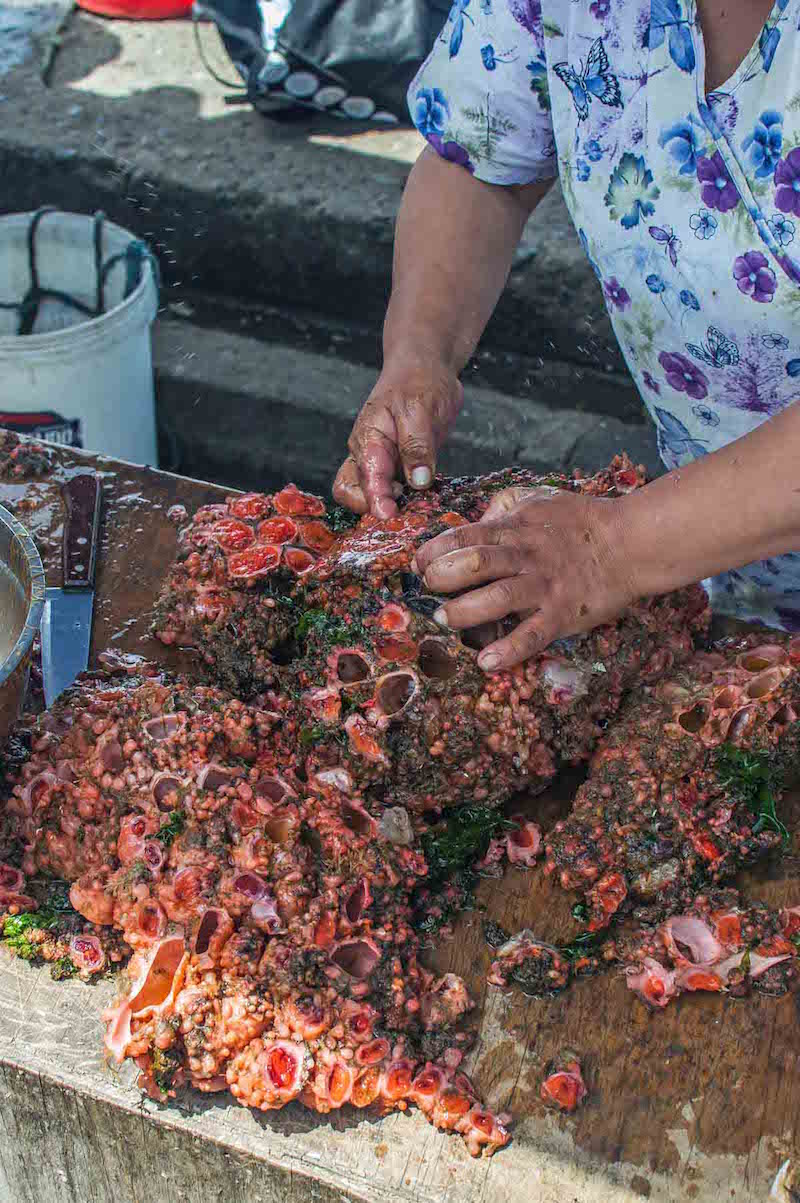
Walk along Pedro Montt away from the ferry wharf, the road that runs along the waterfront, and you come across a small stand selling freshly caught fish, maybe some scallops and a big old lump of this.
Sea squirts.
It may be a tad confronting to some, but this is common food in these parts. Each sea squirt is removed from the main ‘body’ and sold by weight. They’re eaten raw, mixed into ceviche or tossed into paila marina, a delicious soup that’s very popular in Chile.
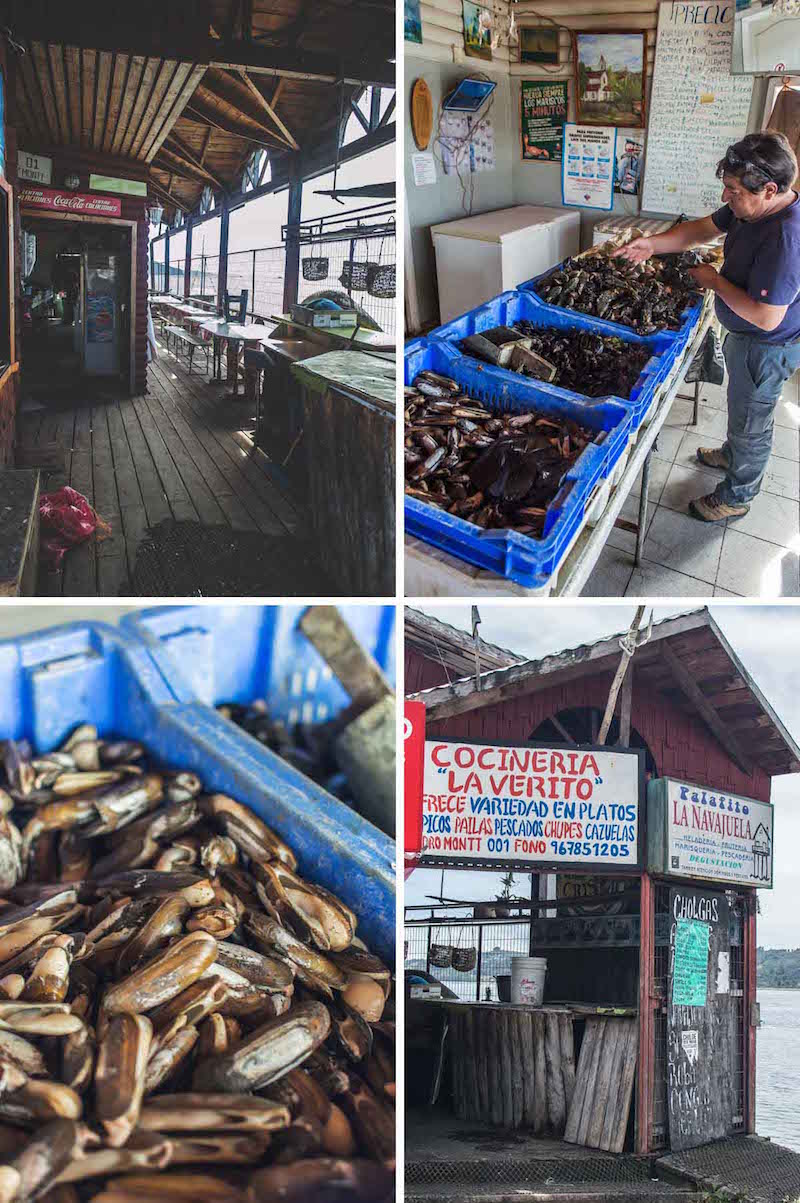
A little further from the seafood stand is Palafito La Navajuela, a small seafood shop where you can grab some clams, mussels or whatever seafood may have been caught that morning. They sell a few vegetables and eggs, as well.
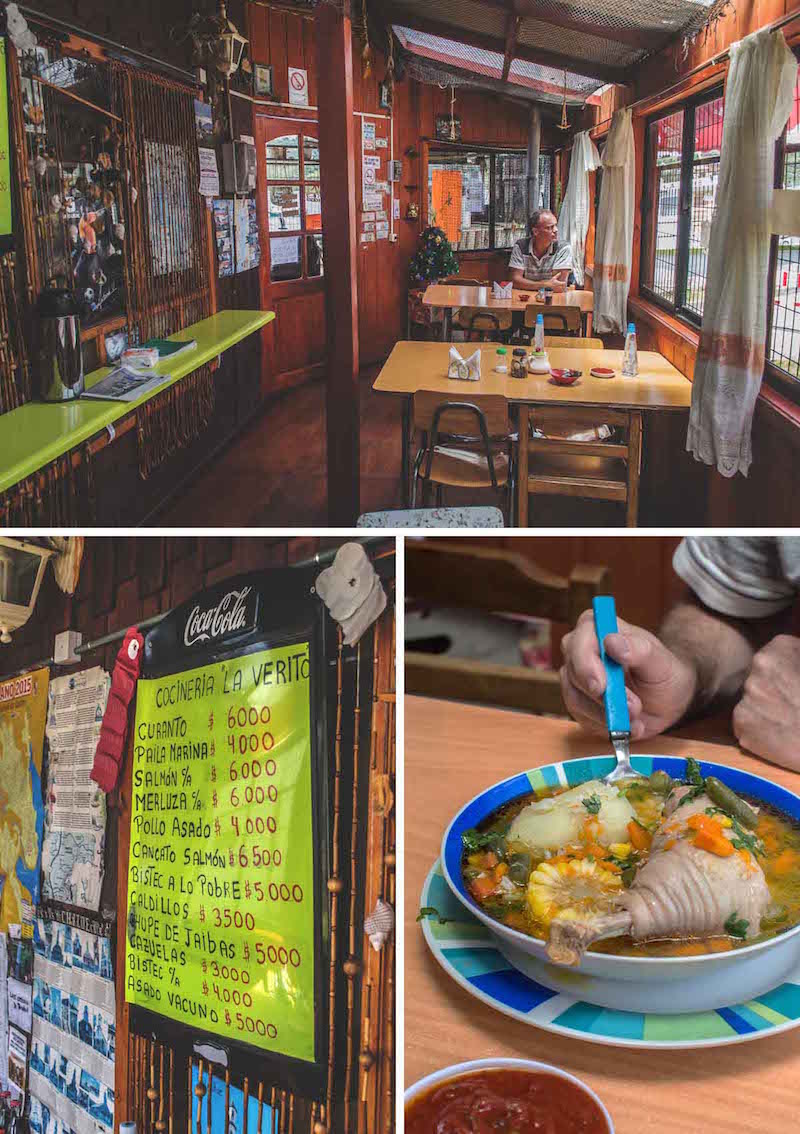
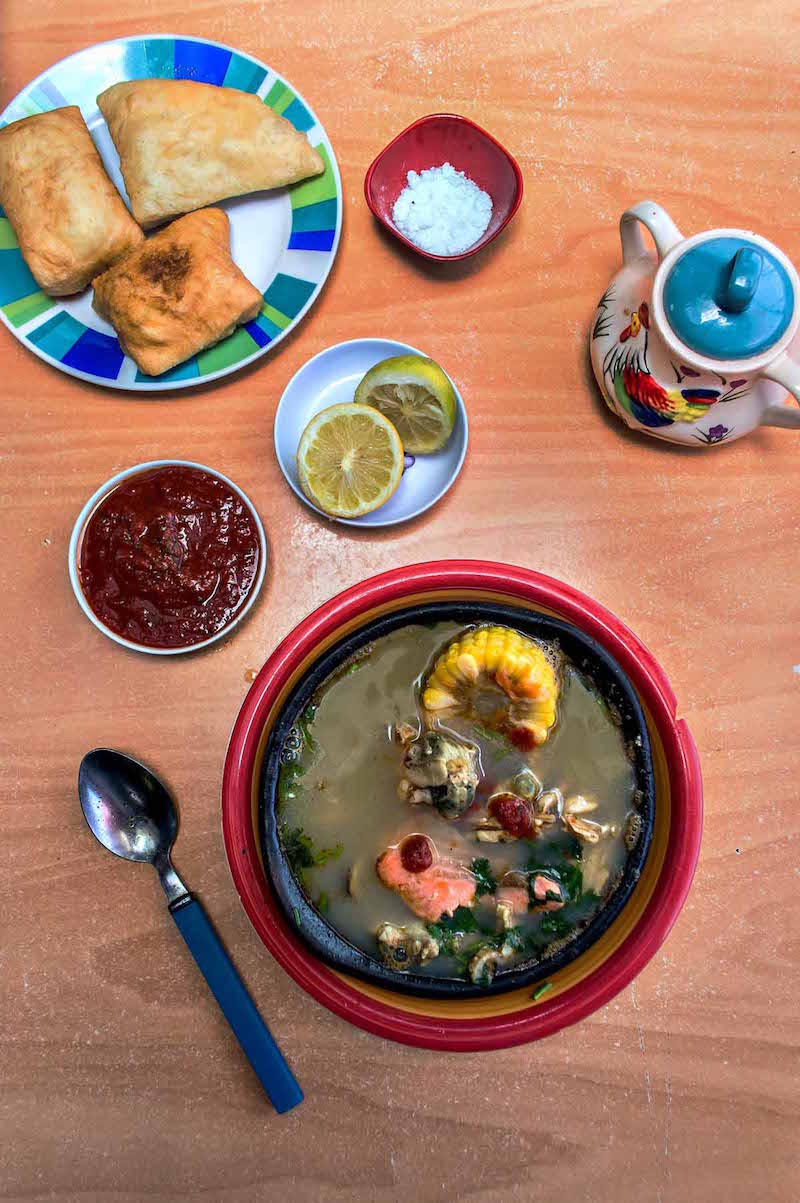
In the same ‘shack’ is Cocineria La Verito, a tiny eatery tempts its visitors with handful of dishes scribed up on a small menu board. I was excited to see curanto on the menu, what could be the signature dish of Chiloé – a combination of seafood, meats, sausage and potatoes, all wrapped and cooked in nalca leaves in a pit or pot.
Sadly I was told it wasn’t available, which meant I lost my final chance of trying curanto. Seriously not happy about that.
We settled on a couple of soups – cazuelas (3000), which is a brothy chicken soup loaded with vegetables – and paila marina (4000), a seafood soup I first tried in Puerto Natales, and the difference with this one was its addition of sea squirts.
Dishes also get served with a local bread known as chapalele, where cooked potatoes are mixed with flour to form a dough, then it’s cut and deep-fried. Kind of like a potato doughnut.
Cocineria La Verito & Palafito La Navajuela, Pedro Montt
Car rental, road tolls and ferry cost.
Puerto Varas has many rental companies, so it pays to shop around before signing any contract. The cheapest place we found was Hunter Rent a Car at San José 130 opposite Plaza de Armas. Great service, great cars and absolutely no issues.
We got a small 4-door, near-new car for CLP$20,000 per day. That’s about AUD$40. Bargain.
There are a couple of road tolls between Puerto Varas and the Pargua ferry, so it’s advisable to have small notes or coins on hand. As for the ferry cost per car, it was 11,800 pesos one way, and takes about 30 minutes to cross the channel. There’s even free wifi on the ferry.
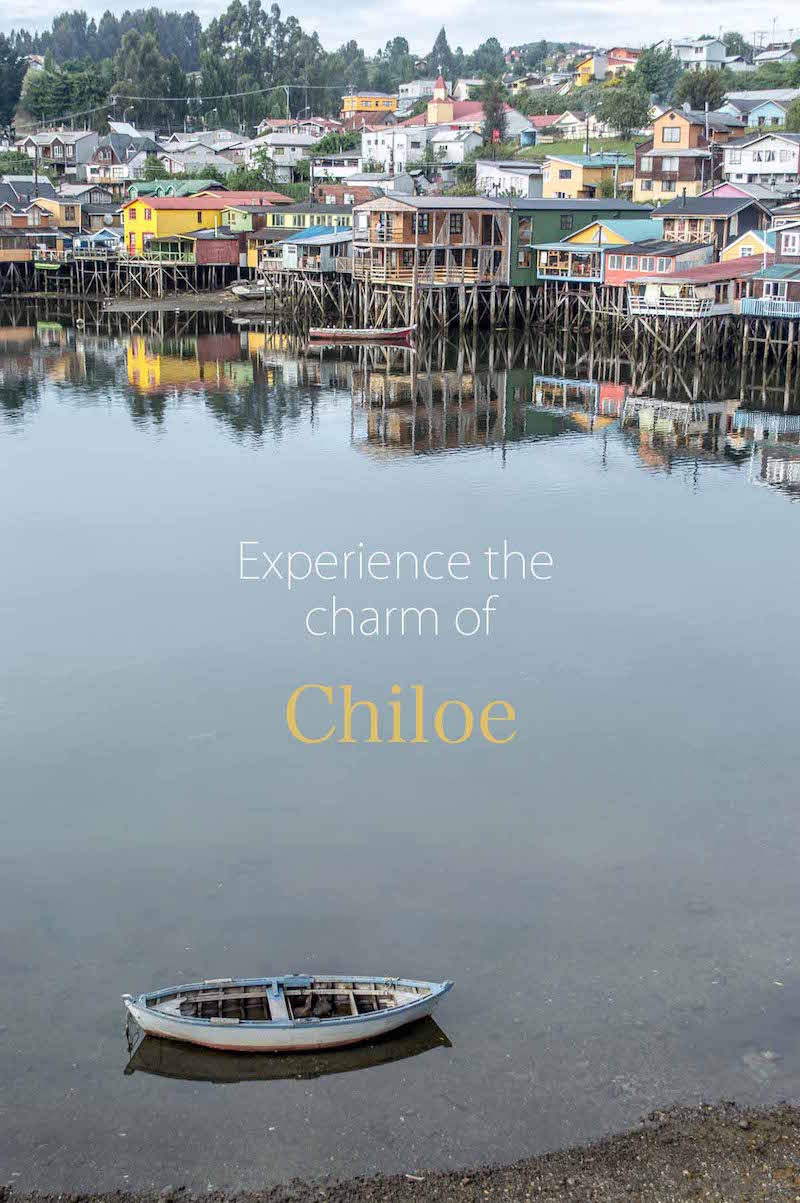







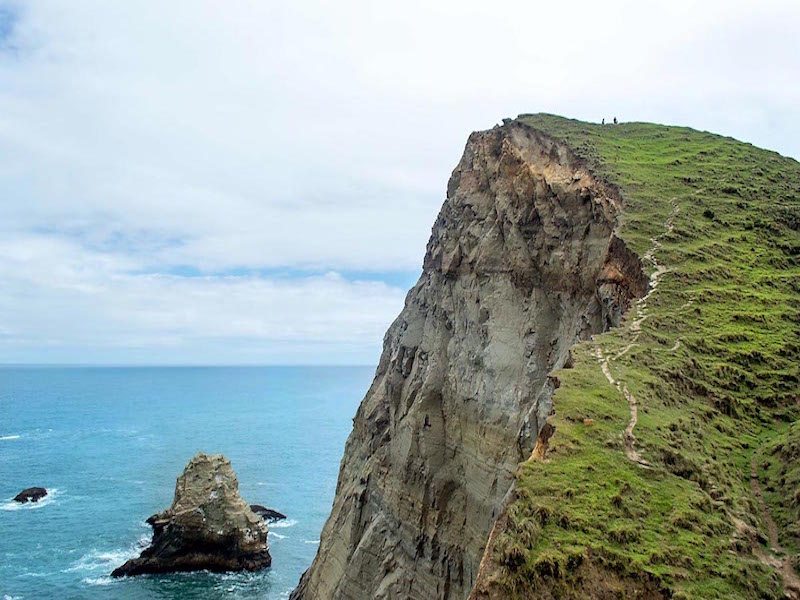







I love your photos of Chiloe! I went there back in 2009 and thought it was such a beautiful place, but didn’t explore it enough. We are actually going there in a few days and your pictures definitely inspire me to travel around there more! Thanks :)
Tam @ http://freshcoffeestains.com